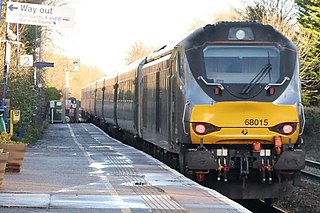
Chiltern Railways is a British train operating company that has operated the Chiltern Railways franchise since July 1996. Since 2009, it has been a subsidiary of Arriva UK Trains.

Birmingham International is a railway station known by code "BHI" in the Metropolitan Borough of Solihull in the West Midlands of England, just east of Birmingham. It is on the Rugby–Birmingham–Stafford line 14 km (8.7 mi) east of Birmingham New Street railway station. BHI serves Birmingham Airport, the National Exhibition Centre, the Resorts World Arena, and Resorts World Birmingham.

The West Midlands Metro is a light-rail/tram system in the county of West Midlands, England. The network has 33 stops with a total of 14 miles (23 km) of track; it currently consists of a single route, Line 1, which operates between the cities of Birmingham and Wolverhampton via the towns of Bilston, West Bromwich and Wednesbury, on a mixture of former railway lines and urban on-street running. The system is owned by the public body Transport for West Midlands, and operated by Midland Metro Limited, a company wholly owned by the West Midlands Combined Authority.

Birmingham Airport, formerly Birmingham International Airport, is an international airport located 7 nautical miles east-southeast of Birmingham city centre, 9.5 nautical miles west-northwest of Coventry slightly north of Bickenhill village, in the Metropolitan Borough of Solihull, England.

Birmingham is a major transport hub, due in part to its location in central England. The city is well connected by rail, road, and water. Public transport and key highways in the city are overseen by Transport for West Midlands (TfWM).
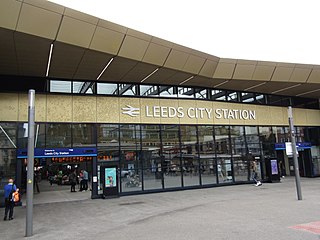
Leeds railway station is the mainline railway station serving the city centre of Leeds in West Yorkshire, England. It is the third-busiest railway station in the UK outside London. It is located on New Station Street to the south of City Square, at the foot of Park Row, behind the landmark Queens Hotel. It is one of 20 stations managed by Network Rail.

Transport for West Midlands (TfWM) is the public body responsible for co-ordinating transport services in the West Midlands metropolitan county in England. It is an executive body of the West Midlands Combined Authority (WMCA), with bus franchising and highway management powers similar to Transport for London. TfWM's policies and strategy are set by the Transport Delivery Committee of the WMCA.
The Stonebridge Railway was a railway line between Whitacre Junction and Hampton-in-Arden in Warwickshire, England, passing through Stonebridge. It had an intermediate station at Coleshill, which was renamed Maxstoke in 1923.

Stourbridge Town is a railway station near the centre of Stourbridge, West Midlands, England. It is situated at the end of a short branch line linking the station with Stourbridge Junction, 0.8 miles away, where passengers can change for mainline train services. It is said to be the shortest operational branch railway line in Europe.

Old Oak Common (OOC) is a railway station under construction on the site of the Old Oak Common traction maintenance depot to the west of London in Old Oak Common, approximately 500 m (1,600 ft) south of Willesden Junction station. When built, it is expected to be one of the largest rail hubs in London, at about 800 m (2,600 ft) in length and 20 m (66 ft) below surface level.

High Speed 2 (HS2) is a planned high-speed railway line and network of passenger train services in Great Britain. The new railway line, which is currently under construction in England, is to run between the West Midlands and London, with a spur to Birmingham. A network of train services will use the new line and existing conventional track to reach their destinations in the Midlands, North West England, and Scotland. HS2 is to be Britain's second purpose-built high-speed line after High Speed 1, which connects London to the Channel Tunnel. The majority of the project is planned to be completed between 2029 and 2033.
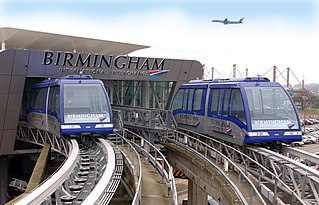
The Air-Rail Link is a people mover linking Birmingham Airport with Birmingham International railway station and the National Exhibition Centre in England. The current system, originally known as SkyRail, replaced the earlier Birmingham Maglev system in 2003.
Heathrow Hub railway station was a proposed interchange that would serve – mainly – a now disbanded potential alignment of High Speed 2 (HS2) services that would adjoin the expanded part of Heathrow Airport, England. It was a cornerstone part of an expansion plan put forward in 2008, by engineering firm Arup, to set up the UK's first high-speed rail network north-west of London.

Birmingham Curzon Street railway station is the planned northern terminus of High Speed 2 in the city centre of Birmingham, England. The new railway will connect Birmingham to London Euston via Birmingham Interchange and Old Oak Common. Curzon Street will have seven terminal platforms and is planned to open in 2026.
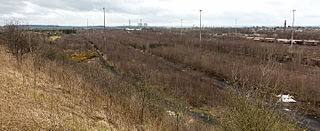
East Midlands Hub was a planned new railway station on the Leeds Branch of High Speed 2. It was intended to be located on the existing railway sidings in Toton, situated between Nottingham and Derby. The station would have been located adjacent to the M1 motorway in Nottinghamshire, on the border with Derbyshire.

Northern Powerhouse Rail (NPR), sometimes referred to unofficially as High Speed 3, is a proposed major rail programme designed to substantially enhance the economic potential of the North of England. The phrase was adopted in 2014 for a project featuring new and significantly upgraded railway lines in the region. The aim is to transform rail services between the major towns and cities, requiring the region's single biggest transport investment since the Industrial Revolution. The original scheme would have seen a new high-speed rail line from Liverpool to Warrington continuing to join the HS2 tunnel which it would share into Manchester Piccadilly station. From there, the line would have continued to Leeds with a stop at Bradford. The line was intended to improve journey times and frequency between major Northern cities as well as creating more capacity for local service on lines that express services would have been moved out from.

The history of High Speed 2 is the background to the planned construction of High Speed 2 (HS2), a new high-speed railway in Great Britain that would connect London, Birmingham, Manchester, Leeds and other cities in the UK.
Coventry Very Light Rail (CVLR) is a light rail/tram system proposed to operate in Coventry. The system has been promoted as being the first of its kind in the United Kingdom. When finished, it will also be the first tram network to operate in Coventry since the Second World War.
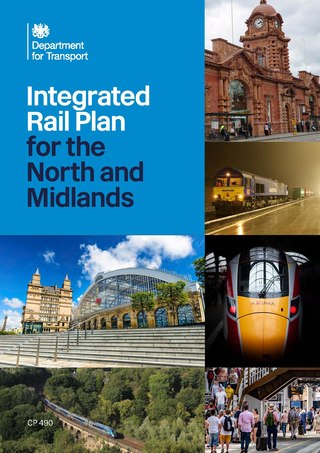
The Integrated Rail Plan for the North and Midlands or more simply, the Integrated Rail Plan (IRP), is a United Kingdom government proposal published on 18 November 2021. It aims to deliver "increased capacity, faster journeys or more frequent services on eight out of the top ten busiest rail corridors across the North and Midlands", by developing rail services along with the required infrastructure in these regions of England. It was published by the Department for Transport (DfT) and features forewords by Prime Minister Boris Johnson and Transport Secretary Grant Shapps, but its publication was delayed a number of times, partly because of the COVID-19 pandemic. It contains the significant proviso that "In line with the Government's existing approach to rail enhancements, commitments will be made only to progress individual schemes up to the next stage of development, subject to a review of their readiness." A Technical Annexe was published in January 2022. A correction slip was issued March 2022.
The HS2 automated people mover is a planned automated people mover (APM) in Solihull, England being built in conjunction with the High Speed 2 project in order to improve connections between HS2's upcoming Interchange station, Birmingham Airport, and other rail and community infrastructure.
















